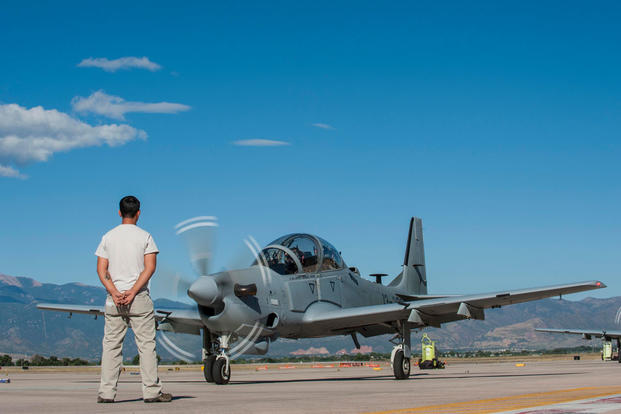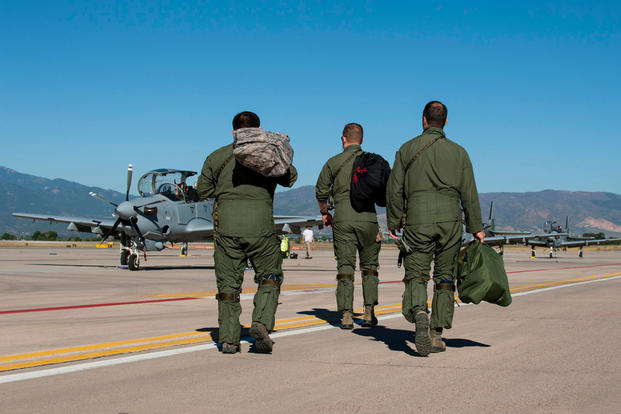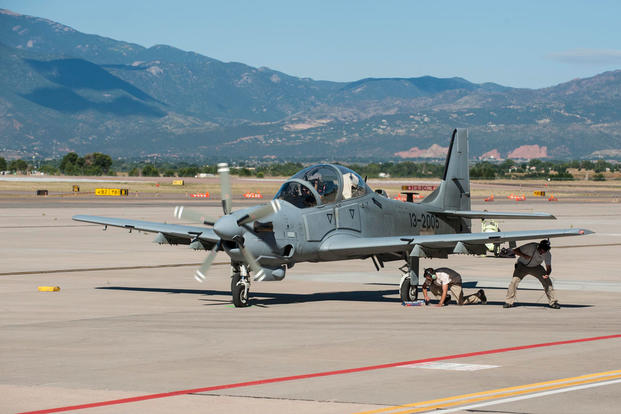PETERSON AIR FORCE BASE, Colo. — Afghan pilots, maintainers and instructor pilots from the 81st Fighter Squadron at Moody Air Force Base, Georgia, came here this month to conduct high-altitude training in the mountainous terrain.
Since the beginning of 2015, four Afghan pilots have been training with the 81st FS to receive extensive knowledge and application of flying A-29B Super Tucanos, as well as the inner workings of Air Force fighter squadrons, to help them stand up their own squadron back in Afghanistan.
The 81st FS is a stateside air advisor unit with a deployed mission, said Lt. Col. Jeff Hogan, the 81st FS commander. When the first group of Afghan pilots and maintainers finish their year-long training, the 81st FS will send Air Force pilots and maintainers to Afghanistan for support.
“We'll have a constant rotational presence in Afghanistan, helping mentor them as they stand up this new capability," he said.
The end result of this training is for Afghanistan to have its own air force that can sustain itself, Hogan said, adding that the U.S. partnered with the NATO coalition since the initial invasion and is in a good position to help train the pilots.
"There are other nations that could have done it, but we certainly have the capacity and the know-how on how to train our international partners," Hogan said. “It's a core (Air Education and Training Command) competency. We train thousands of international students a year.”
The training is aimed at propping up an Afghan-run fighter squadron that can provide aerial fire support for Afghan ground forces, Hogan said. To achieve that, the 81st FS is training the pilots on four different missions, including close air attack, air interdiction, helicopter and convoy escort, and armed reconnaissance.
The aircraft the pilots train on will go back with them to Afghanistan at the end of their training, according to instructor pilots. They’ll replace the aging Mi-35 attack helicopters, which have limited capabilities.
The training initially began at Moody AFB, which has an elevation of around 200 feet and doesn't compare to the high elevations in Afghanistan, according to 81st FS officials, who added that the Afghan pilots came to Peterson for more realistic training.
As with any mechanical equipment, performance is lower at a higher altitude, instructor pilots said. Since the air is less dense and has fewer molecules, aircraft can take longer to accelerate and it's more difficult to get off the ground, they added.
"Peterson afforded us some great facilities," Hogan said. "We're very thankful for the support we've received here. This is probably the place that most closely approximated (Afghanistan) and what we were trying to do. We received a very warm welcome and we were thankful to get that."
The most satisfying part of this training, Hogan said, is the opportunity to build another country's air force.
"This airplane will allow us to truly start to step away from Afghanistan," Hogan said. "When they can provide their own organic fires, support their own soldiers in the field and provide them with close air support capabilities — that will be the major turning point that allows our country to disengage."





























